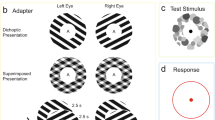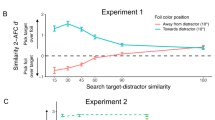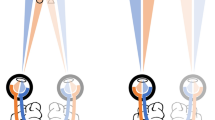Abstract
A question of long-standing interest to philosophers, psychologists and neuroscientists is how the brain selects which signals enter consciousness1,2. Binocular rivalry and attention both involve selection of visual stimuli, but affect perception quite differently. During binocular rivalry, awareness alternates between two different stimuli presented to the two eyes. In contrast, attending to one of two different stimuli impairs discrimination of the ignored stimulus, but without causing it to disappear from consciousness. Here we show that despite this difference, attention and rivalry rely on shared object-based selection mechanisms. We cued attention to one of two superimposed transparent surfaces and then deleted the image of one surface from each eye, resulting in rivalry. Observers usually reported seeing only the cued surface. They were also less accurate in judging unpredictable changes in the features of the uncued surface. Our design ensured that selection of the cued surface could not have resulted from spatial, ocular or feature-based mechanisms. Rather, attention was drawn to one surface, and this caused the other surface to be perceptually suppressed during rivalry. These results raise the question of how object representations compete during these two forms of perceptual selection, even as the features of those objects change unpredictably over time.
This is a preview of subscription content, access via your institution
Access options
Subscribe to this journal
Receive 51 print issues and online access
$199.00 per year
only $3.90 per issue
Buy this article
- Purchase on Springer Link
- Instant access to full article PDF
Prices may be subject to local taxes which are calculated during checkout


Similar content being viewed by others
References
James, W. The Principles of Psychology Vol. 1 (Henry Holt, New York, 1890)
von Helmholtz, H. Handbuch der physiologischen Optik 3rd edn (Voss, Hamburg, 1909)
Lack, L. Selective Attention and the Control of Binocular Rivalry (Mouton, The Hague, 1978)
Ooi, T. L. & He, Z. J. Binocular rivalry and visual awareness: the role of attention. Perception 28, 551–574 (1999)
Posner, M. I. Orienting of attention. Q. J. Exp. Psychol. 32, 3–25 (1980)
Treisman, A. M. & Gelade, G. A feature-integration theory of attention. Cogn. Psychol. 12, 97–136 (1980)
Duncan, J. Selective attention and the organization of visual information. J. Exp. Psychol. Gen. 113, 501–517 (1984)
Schoenfeld, M. A. et al. Dynamics of feature binding during object-selective attention. Proc. Natl Acad. Sci. USA 100, 11806–11811 (2003)
Blake, R. R. & Logothetis, N. K. Visual competition. Nature Rev. Neurosci. 3, 13–23 (2002)
Valdes-Sosa, M., Cobo, A. & Pinilla, T. Attention to object files defined by transparent motion. J. Exp. Psychol. Hum. Percept. Perform. 26, 488–505 (2000)
Pinilla, T., Cobo, A., Torres, K. & Valdes-Sosa, M. Attentional shifts between surfaces: effects on detection and early brain potentials. Vision Res. 41, 1619–1630 (2001)
Reynolds, J. H., Alborzian, S. & Stoner, G. R. Surface-based exogenous cueing triggers automatic competitive selection. Vision Res. 43, 59–66 (2003)
Mitchell, J. F., Stoner, G. R., Fallah, M. & Reynolds, J. H. Attentional selection of superimposed surfaces cannot be explained by modulation of the gain of color channels. Vision Res. 43, 1323–1328 (2003)
Blaser, E., Pylyshyn, Z. W. & Holcombe, A. O. Tracking an object through feature space. Nature 408, 196–199 (2000)
Sasaki, H. & Gyoba, J. Selective attention to stimulus features modulates interocular suppression. Perception 31, 409–419 (2002)
Logothetis, N. K., Leopold, D. A. & Sheinberg, D. L. What is rivalling during binocular rivalry? Nature 380, 621–624 (1996)
Lee, S. H. & Blake, R. Rival ideas about binocular rivalry. Vision Res. 39, 1447–1454 (1999)
Diaz-Caneja, E. Sur l'alternance binoculaire. Ann. Oculist October, 721–731 (1928)
Whittle, P., Bloor, D. C. & Pocock, S. Some experiments on figural effects in binocular rivalry. Percept. Psychophys. 4, 183–188 (1968)
Kulikowski, J. J. Binocular chromatic rivalry and single vision. Ophthalmol. Physiol. Opt. 12, 168–170 (1992)
Kovacs, I., Papathomas, T. V., Yand, M. & Feher, A. When the brain changes its mind: interocular grouping during binocular rivalry. Proc. Natl Acad. Sci. USA 93, 15508–15511 (1996)
Alais, D. & Blake, R. R. Interactions between global motion and local binocular rivalry. Vision Res. 38, 637–644 (1998)
Alais, D. & Blake, R. R. Grouping visual features during binocular rivalry. Vision Res. 39, 4341–4353 (1999)
Sobel, K. V. & Blake, R. How context influences predominance during binocular rivalry. Perception 31, 813–824 (2002)
Ooi, T. L. & He, Z. J. A distributed intercortical processing of binocular rivalry: psychophysical evidence. Perception 32, 155–166 (2003)
Castelo-Branco, M., Goebel, R., Neuenschwander, S. & Singer, W. Neural synchrony correlates with surface segregation rules. Nature 405, 685–689 (2000)
Thiele, A. & Stoner, G. Neural synchrony does not correlate with motion coherence in cortical area MT. Nature 421, 366–370 (2003)
Leopold, D. A. & Logothetis, N. K. Activity changes in early visual cortex reflect monkeys' percepts during binocular rivalry. Nature 379, 549–553 (1996)
Sheinberg, D. L. & Logothetis, N. K. The role of temporal cortical areas in perceptual organization. Proc. Natl Acad. Sci. USA 94, 3408–3418 (1997)
Leopold, D. A. & Logothetis, N. K. Multistable phenomena: changing views in perception. Trends Cogn. Sci. 3, 254–264 (1999)
Acknowledgements
We thank F. Crick, G. Horwitz, H. Jordan, B. Krekelberg, M. Richert and K. Sundberg for providing comments on the manuscript, and J. Reyes and C. Williams for testing subjects. J.M. was funded by an NIH Training Grant in Cognitive Neuroscience, G.S. was funded by an NEI grant and J.R. was funded by grants from NEI, The Sloan Foundation, and The McKnight Foundation.
Author information
Authors and Affiliations
Corresponding author
Ethics declarations
Competing interests
The authors declare that they have no competing financial interests.
Supplementary information
Supplementary Methods
This file provides details of the ANOVA analyses described in the manuscript text and also describes a control that verified that differences in the second translation duration did not contribute to the differences in the early time courses found between rivalry and monocular transparency conditions. (DOC 24 kb)
Rights and permissions
About this article
Cite this article
Mitchell, J., Stoner, G. & Reynolds, J. Object-based attention determines dominance in binocular rivalry. Nature 429, 410–413 (2004). https://doi.org/10.1038/nature02584
Received:
Accepted:
Issue Date:
DOI: https://doi.org/10.1038/nature02584
This article is cited by
-
Adaptation to transients disrupts spatial coherence in binocular rivalry
Scientific Reports (2020)
-
A critical review of selective attention: an interdisciplinary perspective
Artificial Intelligence Review (2013)
-
Modeling perceptual multi-stability with Hodgkin-Huxley neurons
BMC Neuroscience (2008)
-
Attentional modulation of motion-induced blindness
Chinese Science Bulletin (2007)
-
Psilocybin links binocular rivalry switch rate to attention and subjective arousal levels in humans
Psychopharmacology (2007)
Comments
By submitting a comment you agree to abide by our Terms and Community Guidelines. If you find something abusive or that does not comply with our terms or guidelines please flag it as inappropriate.



